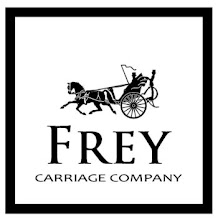
Many carriage manufacturers used subcontractors for supplies and parts. Here is a good example of that. The axle on this Kimball Carriage was manufactured by S.A.- F.E. Company of New York. These axles were complex in design and as you can see they were also patented to protect their innovations.

Dale is in the process of painting the chassis for the Brougham by C.P. Kimball. As restorers it is our purpose to reproduce or recreate the intent as well as the finished product of the original manufacturer. Here you can see the front gear of that vehicle. It might be a little hard to appreciate this from the photo but the beauty of the design of this component is special. It is a functional part of a carriage just like the chassis of your automobile. Carriage builders of the day didn’t have the luxury of covering it all up with sheet metal. They needed to make the structure beautiful and fit the entire design concept of the entire vehicle. Not an easy task.

Here is a shot of the rear axle. On the other hand simplicity reins here. The body in the rear of the carriage is much larger and more pronounced so the chassis plays a smaller roll in the design.

This is an example of what I’m talking about with details. The carved wood ends on this fifth wheel support are beautifully artistic. They are sort of Art Deco in nature. The carriage predates the Art Deco movement but I suppose the design is maybe somewhat Prairie Style as well which is a little more timely. Someone that studied art history needs to chime in on that one for me. I’m certain there is a term for this design in this time period of the late 1800’s. It is rather contemporary considering when this carriage was produced. That being said it is not completely unique to this carriage. I have seen this design or designs similar to it on other vehicles of good breeding.

Shifting gear we are continuing work on the Show Gig. Bob block sanded the body today. That is the first primer coat and the sanding process with a block is what levels the body for a smooth finish. You can see lighter spots on the back panel. Those are high spots on the body that sanded through first. When you see that happening you know the block is doing its job.

As you can see here we created a compound curve on the upright seat support. This type of detail adds nice dimension to the carriage body. We are not the first, we are just using the techniques that we have seen by the masters that came before us.
So expecting another really busy day here at the shop. Continuing work on a number of projects as well as trying to wrap up that to-do list before the weather gets bad. Sounds like we are going to have a few nice days so here is that opportunity to finish up the outside jobs.
Have a great Thursday!
T







3 comments:
Great, Todd! Too few people appreciate or are even aware of the details of original vehicles. Keep up the good work and keep shouting about it.
The pattern on the end of the bolster predates "art deco" by something like 3,000 years ... it's based on ancient Greek "fret" or "key" art work called a "meander". A meander is a pattern based on a continuous line ... just like we go for a meander around the garden. You see a lot of meanders on belt lines and panel work. I recently viewed some on a 1912 Rolls Royce Shooting Break, it was all executed in inlaid rose wood on mahogany on the belt line ( 1" wide by probably 20' if it was a foot); the3 "lines" were 1/8" wide rosewood). "Art Deco" just rediscovered its elegance and simplicity. Google "greek meander" and see what you find. BTW, love your work. My great grandfather was wagon builder down in Paris, Illinois in the 1880-90s. Lew Morris, Pismo Beach, California/Industrial Designer/Purdue, 1973.
n4e15r9k99 k0l00b7m57 t0u60g5k76 r8i30o9e02 s9w20p5x50 l4v50o5a74
Post a Comment